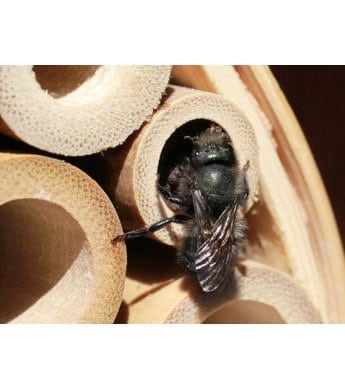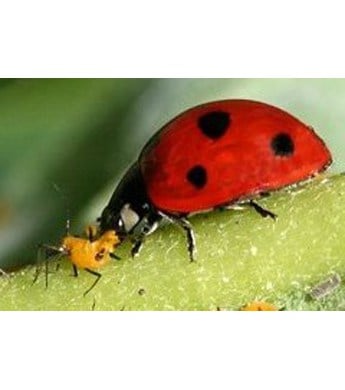A happy, healthy garden is often teaming with activity. Growing, blooming, fruiting, crawling, and buzzing. But how do we make sure the insects we have in the garden are helping, not hurting? Beyond butterflies and honeybees, there are lots of insects we hope and even encourage to live in our gardens.

POLLINATORS & PREDATORS
Everyone knows about honeybees and how they collect nectar from flowers to make honey, depositing pollen from one plant to another to create fruit. But bees are only a small percentage of insects in the garden that help with pollination. And while pollination is important, so is pest control. Many insects serve in both capacities, creating a wonderful dual-purpose insect.

Mason Bees
Among the best pollinators is the mason bee. Mason bees don’t make honey, but they are nearly 120 times more effective than honeybees. One of the reasons is they collect pollen all over their body, while honeybees only carry it on their back legs. This means mason bees pollinate flowers 95% of the time, while honeybees only pollinate 5% of the time.
The easiest way is by purchasing a kit and setting it up near your garden. Kits consist of a bee house, tube inserts for the bee tunnels, and a handful of mason bee cocoons ready to place inside the house before spring.
In addition to a proper home, mason bees need access to clay-type mud for sealing their eggs into each tube – like a brick mason. They also need to have spring blooming flowers from which to collect pollen. Asylum, yarrow, lavender, mint, and pansies are wonderful spring bloomers. Mason bees have a very short life span – about four weeks. They hatch between February and May, hatching when the weather reaches about 55 degrees. They then eat, collect pollen, lay eggs, and die. Asylum, yarrow, lavender, mint, and pansies are wonderful spring bloomers.

Hover Flies
Like their name suggests, hover flies can be found hovering like helicopters over flowers in the garden. With yellow and black striped bodies, they are sometimes mistaken for yellow jackets, but these little flies aren’t mean like their counterparts. In fact, hover flies are just interested in getting a meal of nectar and pollen. This makes them another successful pollinator. In addition to the pollinating adults, hover fly larvae are excellent pest protection eating aphids, caterpillars, beetles, and thrips.

Soldier Beetles
Another pollinator that is easily mistaken for a nuisance is the soldier beetle. More fly than beetle, this wonderful creature is a great pollinator. It enjoys compound flowers – flowers with lots of little blossoms together – and is especially drawn to yellow ones. While like the hover fly, they ressembe a wasp, these beetles are harmless. And like the hover fly, soldier beetle larvae love to snack on pests including slug, snail, and caterpillar eggs.

Ladybugs
Ladybugs are excellent pest control. One ladybug can eat around 60 aphids a day – that’s more than 5000 insects in a lifetime. Because these insects are actually beetles, they go through a full metamorphoses. When in their pupa state, they look a bit like a tiny black alligator and are voracious eaters. When aphids aren’t around, ladybugs like other bad bugs too including leaf hoppers, mealy bugs, and mites. Make sure to plant lots of extra flowers – especially umbrella shaped flowers like yarrow and dill, giving ladybugs a source of pollen as well.
You can buy ladybugs from the store in small containers. Generally they are kept in a cool place – like a refrigerator – until they can be released into the garden. Make sure to release them in the evening so they stick around long enough to check out the local meals in the morning. Ladybugs are fickle and will go where the best meal can be found.

Lacewings
One of the best predatory insects available is the lacewing. Not only does it have a wonderful appetite for aphids and other pests, it is the most likely insect to stick around awhile. Like ladybugs, you can buy lacewings from the store. And like ladybugs, lacewing larvae look a bit like an alligator. They snack on aphids and other soft bodied insects. But unlike ladybugs, lacewings are willing to set up shop in a garden and eat a variety of pests before they give up and move on.
A great balance is to buy a combination of ladybugs and lacewings. This way you get lots of larvae to knock down the aphid population quickly, and as the ladybugs move on to greener pastures, the lacewings will stick around to keep things clean.

Praying Mantids
Finally, the praying mantis. This capable predator is more likely to eat larger pests in the garden, including caterpillars, moths, and grasshoppers. Mantids are even known to eat small rodents and snakes. With their nimble green bodies and strong jaws, they can capture and kill their prey quickly. You can buy an egg case of praying mantids from the store. Watch the case closely so the insects can be released immediately. While praying mantids are great predators, they don’t discern between their own kind and others. If left in a confined space together, praying mantids will eat each other. Dill, marigold, and fennel are some mantid approved plants. Also making sure there is shady cover for them to hide.
With all beneficial insects, you can take a couple of steps to encourage them to inhabit your garden. Planting a variety of flower types and bloom times gives beneficial insects who rely on pollen and nectar during part or all their lifespan choices. Making sure there is ample ground cover and shade vegetation helps ensure hiding places for eggs and larvae.
Whether you are looking for pollinators or predators, keep an eye out for some of the beneficial insects listed above. They are important for fruit production and are an excellent option to pesticides. And some of them are even kind of cute.



